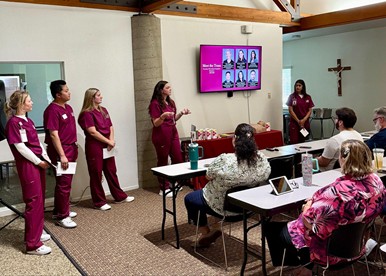Lifesavers in the Hallways and Classrooms: Overdose Prevention Committee Provides Naloxone Training to Local Junior High and High School Teachers
August 21, 2025

Written by Brooke Guenther, CHSU-COM Student & OPC Chair
On Wednesday, August 13th, the California Health Sciences University College of Osteopathic Medicine (CHSU-COM) Overdose Prevention Committee (OPC) trained over 60 local junior high and high school teachers on proper opioid overdose recognition and intranasal naloxone (Narcan) administration. San Joaquin Memorial High School (SJM), an established educational institution in Fresno for the last eight decades, and the newer junior high, Holy Cross, have incorporated overdose response into their annual in-service training.
The OPC Board worked closely with faculty advisor and emergency medicine clinical pharmacist, Francisco Ibarra, PharmD, BCCCP, to create a streamlined, informative training presentation. The training covered not only the pharmaceutical characteristics of opioids and the physiological effects of the drugs on the body, but also the populations at risk and how accidental overdoses can occur. The presentation ended with OPC board members ensuring attendees could appropriately respond to an opioid overdose.
As medical students, the OPC Board spends each day in the classroom, so getting to stand in front of a room full of teachers was a welcome change. The teachers embraced the flipped roles and were eager to answer questions throughout the training in hopes of securing a take home intranasal naloxone (Narcan) and bragging rights. Following the presentation, teachers broke out into small groups with members of the OPC Board to individually go through the steps in recognizing the signs of an overdose and administering intranasal naloxone (Narcan) using manikins. It was a great opportunity to clarify any questions and ensure every teacher left feeling confident in recognizing an overdose situation and appropriately responding.
Holy Cross and SJM have committed to having intranasal naloxone (Narcan) in each classroom. By equipping teachers with life-saving tools, this initiative fosters a more compassionate school environment that prioritizes student safety and well-being over judgment. Accidental overdoses occur, especially in younger populations, and having the proper training and resources ensures the safety of all, including teachers, staff, and students.